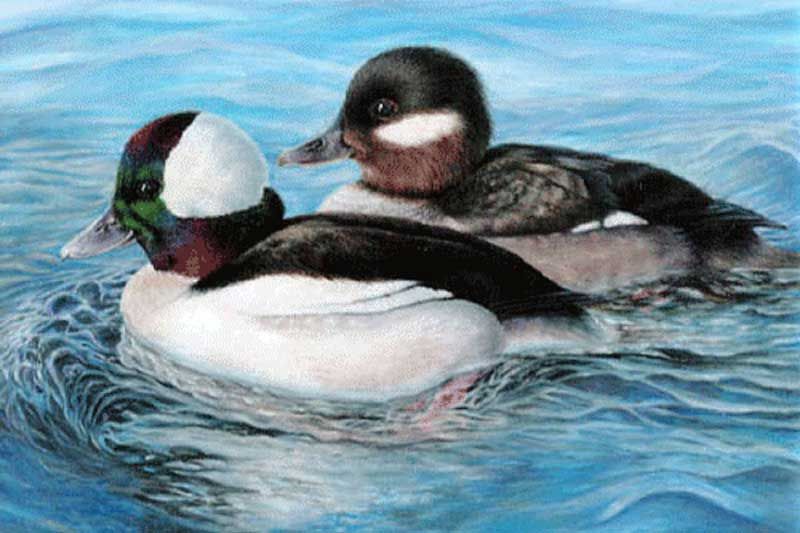Steve Blight | May 15, 2013
by Steve Blight
Every year as soon as the ice is off our pond, I get another opportunity to become reacquainted with North America’s smallest duck, the Bufflehead. With the advent of warmer weather and open water, a couple of males and a small number of females show up every year to glide about, bobbing their heads, chasing each other and occasionally diving below the surface in search of some tasty morsel. I’ve always thought of it as dating, Bufflehead style. But their time with us doesn’t last long, because within a week or so they are gone, off to the boreal forest of the north or the aspen parklands of western Canada to breed and raise their young.
Like many ducks, males and female Buffleheads are very different in appearance. Males are striking black and white from a distance. A closer look at the head shows glossy green and purple setting off the prominent white patch. Females are a subdued gray-brown with a neat white patch on the cheek. Size wise, at around 13 inches (34 cm) Buffleheads are about half the size of mallards, and aren’t much bigger than a small crow.
Buffleheads nest in old woodpecker holes, particularly those made by Northern Flickers. There are a few other ducks that nest in tree holes, including Wood Ducks, Common Goldeneyes and Hooded Mergansers. Some people may find the fact that certain ducks nest in tree holes surprising – we tend to think of ducks nesting in large open nests on the ground. Because Buffleheads are so small, they benefit by using old flicker nests that the larger goldeneyes and mergansers cannot fit into. The female does all the work once incubation of the clutch of eggs begins, with the male leaving to molt. However, Bufflehead pairs often reunite with each other in subsequent years – one of the few species of ducks where this happens.
On freshwater, Buffleheads dive for insects and other aquatic invertebrates like dragonfly and mayfly larvae, water boatmen and snails and clams. They eat some plant material in fall, mainly seeds of pondweeds and bulrushes. In winter they occur mainly on the ocean near the coast where they feed on small marine creatures like shrimp, crabs, snails, mussels, and small fishes and their eggs.
Here are a few more interesting facts about Buffleheads:
In the early twentieth century Bufflehead had become scarce from over-hunting. However populations have recovered somewhat under the protection of the Migratory Birds Convention between the United States and Canada.
An estimate from a few years ago put numbers of Bufflehead at about 1.5 million birds. One estimate suggested there may be as few as one 13,000 nesting pairs in Ontario.
Bufflehead normally live only in North America, but in winter they occasionally show up elsewhere, including far eastern Russia, Japan, Greenland, Iceland, the British Isles, and other parts of Europe. In some of these cases, the birds may have escaped from captivity.
The oldest Bufflehead on record was at least 18 years, 8 months old. It was caught and re-released by a bird bander in New York in 1975.
Buffleheads will nest in appropriately placed nest boxes with small (2.5-inch diameter) openings.
Now that May has arrived, “our” Buffleheads are gone. We’re looking forward until next year to renew our relationship with this diminutive diving duck.
Please feel free to report any observations to Lorraine Julien at This email address is being protected from spambots. You need JavaScript enabled to view it. or Steve Blight at This email address is being protected from spambots. You need JavaScript enabled to view it.
More Stories
- No Winner Yet in Catch The Ace But Fundraising Target Met
- South Frontenac Food Bank Opens Second Location in Battersea
- Sharbot Lake Pentecostal Church Anniversary - 1925-2025
- Frontenac Holistic Health Fair - September 20 At Storrington Centre
- Odd Year For Real Estate - But Sales Are Steady Year Over Year
- 193rd Kingston Fall Fair
- Kim Phuc - the Napalm Girl - To Visit Flinton In November
- South Frontenac Council - September 2
- Sticker Shock - EV Charging Station To Cost North Frontenac Township
- 30th Anniversary Verona Car Show

